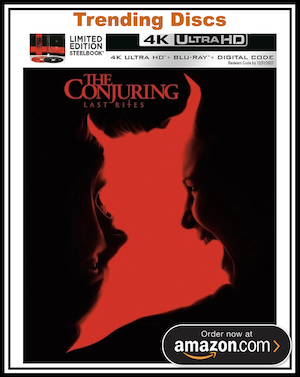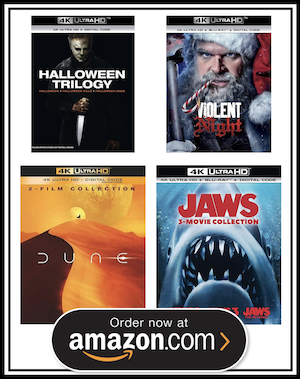Michael Scott
Partner / Reviewer
More
- Preamp, Processor or Receiver
- Yamaha TRS-7850 Atmos Receiver
- Other Amp
- Peavy IPR 3000 for subs
- Universal / Blu-ray / CD Player
- Panasonic UB820 4K UHD Player
- Front Speakers
- Cheap Thrills Mains
- Center Channel Speaker
- Cheap Thrills Center
- Surround Speakers
- Volt 10 Surrounds
- Surround Back Speakers
- Volt 10 Rear Surrounds
- Rear Height Speakers
- Volt 6 Overheads
- Subwoofers
- 2x Marty subs (full size with SI 18's)
- Video Display Device
- Sony 85 inch X950H FALD TV
Liz and the Blue Bird

Movie:
Video:
Audio:
Extras:
Final Score:
Movie:

Video:

Audio:

Extras:
Final Score:

Director Naoko Yamada is no stranger to stories about communication and intense friendships. 2016’s A Silent Voice was a powerful film about communication and empathy in a 2.5 hour film filled with the perils of adolescence. An utter hit, A Silent Voice acts as my favorite Anime film of recenter years (along with Maquia), and Liz and the Blue Bird seemed to be the perfect accompaniment for the emotional experience. On the surface Liz and the Blue Bird seem to share a common theme with communication and friendship, but if you dig deeper the two are almost nothing alike. While A Silent Voice thrived on VERY intense emotional peaks and valleys, Liz and the Blue Bird relies much more on steady pacing and an emotionally distant sense of narration. Not only that it is incorporates music and sound sooooooooooo much into the story telling process that it’s almost impossible to effectively tell the story without the audio track.
The old phrase “If you love something, set it free” comes to mind after viewing Liz and the Blue Bird. The same theme runs rampant throughout the movie as it explores the depths of that concept with two high school seniors preparing for a music duet. Mizore is a quiet and aloof Oboe player who almost CERTAINLY has a crush on on her friend Nozomi. Quiet, reserved, and shy, Mizore has few relationships except for her best friend and it is one of the most intensely personal things for her. On the other hand, we have Nozomi, the vivacious and extroverted flute player who has so many relationships of varying degrees that Mizore is just one of many in her life. The two are asked to perform a duet together for the school’s final concert performance using the song “Liz and the Blue Bird”, which is taken from a German fairy tale of the same name.
As the talks of college and the future arise, it is clear that the duet is not coming together well. The two friends are then forced to come to the realization that their friendship has been drifting apart for some time, and that this duet/friendship is mirroring the themes of separation seen within the song (which is also played out on screen as a parallel story to the main story). While Mizore is pining for the friendship/love of her best friend, the extroverted Nozomi is dealing with demons of her own in side, all of which contributes to the chafing of their relationship. Coming full circle, the statement “if you love something, set it free” comes to play here, as the two girls have to figure out how much of their friendship they can salvage, and how much is better let go into the universe instead of staying stagnant in the relationship.
Just as much as the sound is the physical expressions of the characters. Yamada makes it very clear that she’s more intent on using physical bodily movements to express emotions and sensations rather than simple facial expressions. The result is a strangely complex film that uses all sorts of musical parallels to tell the story, using every movement of the characters to create a harmony that just WORKS.
The show is based off of the anime TV show Sound! Euphonium, but luckily the audience really has no NEED to see the TV series in order to enjoy the movie. You may get a little more out of Liz if you do so being that you have a more intimate knowledge of the characters, but Yamada directs the film so well that the movie acts as a standalone from the series without any need extra background watching. But at the end of the day, this is a film about two friends who are a turning point in their relationship and the struggles they undergo in order to keep that friendship afloat.
Rating:
Not Rated by the MPAA
Video:

Audio:

Extras:
Final Score: 

While it may seems simple and not very complex on the surface, Liz and the Blue Bird is a very intricate story about the necessity of communication and the pitfalls that occur with trying to maintain healthy relationships. It shows us how vulnerable, insecure and frail we can be, while showing the strength and tenacity to succeed and blending the two together in a beautifully immaculate auditory/visual fantasy. The film is based off of an anime (Sound! Euphonium), but viewers need not have any background in the TV show (although it does add a layer of familiarity with certain characters if you’ve seen the series), and in all honesty I think it might benefit the viewer to NOT see the TV show until after watching the movie. It’s an intimate film that thrives on steady pacing and perfect integration of music and sound into the narrative, and while it doesn’t have the same emotional highs as Director Naoko Yamada’s previous film, it is still one of the most satisfying watches of the year in terms of animated film making. Shout Factory’s Blu-ray is incredible on the audio and video fronts, but sadly the disc has NO extras whatsoever. Definitely a very very good watch.
Technical Specifications:
Starring: Atsumi Tanezaki, Nao Toyama, Miyu Honda, Konomi Fujimura, Yuri Yamaoka, Shiori Sugiura, Tomoyo Kurosawa, Ayaka Asai, Moe Toyota, Chika Anzai
Directed by: Naoko Yamada
Written by: Reiko Yoshida
Aspect Ratio: 1.85:1, AVC
Audio: English: DTS-HD MA 5.1, Japanese DTS-HD MA 5.1
Subtitles: English
Studio: Shout Factory
Rated: NR
Runtime: 90 Minutes
Blu-ray Release Date: March 5th, 2019
Recommendation: Great Watch














